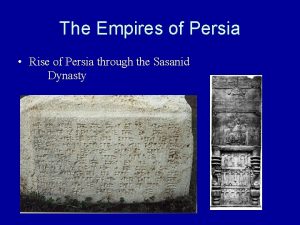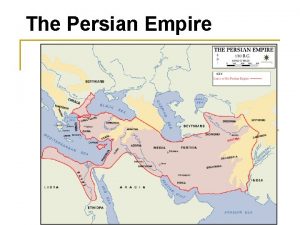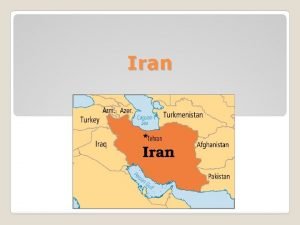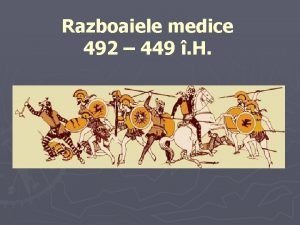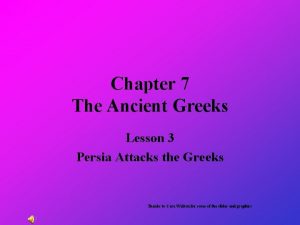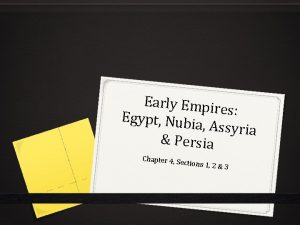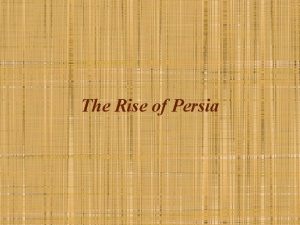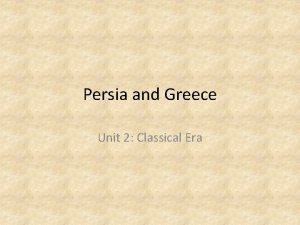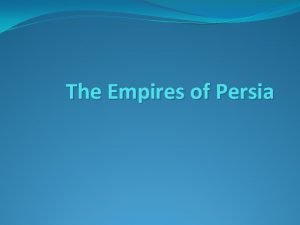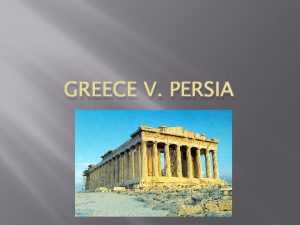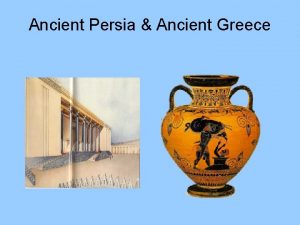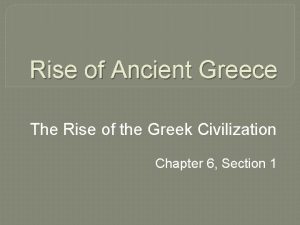Ancient Persia Where was Ancient Persia The Rise
















- Slides: 16

Ancient Persia

Where was Ancient Persia?

The Rise of the Achaemenid Empire 550 -330 BCE • Cyrus the Great 550 BCE conquered Media, Lydia, and Babylonia • Medes – ancient Iranian people in Northwestern Iran • Achaemenid Empire – “First Persian Empire” – Nearly half the world’s population at the time – 4 Major Cities: Pasargadae, Babylon, Susa, Ecbatana

Social Structures - Politics • Satraps – governors of the provinces of the Achaemenid Empire – allowed the Persian Empire to expand flourish – responsible for the land, taxes, court cases, and roads

Social Structures - Religion • Zoroastrianism – one of the oldest monotheistic religions • Cyrus the Great respected the religions and customs of all the peoples from the lands he conquered so long as they pledged allegiance to him and paid taxes

Social Structures - Economic • The Royal Road (Sardis to Susa) – 2, 699 km could be travelled by relays in 7 -9 days – Without shortcut, this route would take ~90 days – King Darius – Horse & man per day – Caravanserais

Achaemenid Dynasty Cyrus the Great (Cyrus II) Cambyses II Darius I Xerxes I • Sister: Atossa married Darius I • Artobazanes • Xerxes with Atossa • Married Esther • Cyrus the Great – ruled for ~30 years [559 -530 BCE], conquered and developed the Persian Empire • Cambyses II – son of Cyrus; ruled for ~8 years [530 -522 BCE}, conquered Egypt (Pharaoh from 525 -522 BCE) • Darius I – Persian official ascended to power; ruled for ~36 years at the Empire’s apex [522 -486 BCE], Royal Road built during his time • Xerxes I – son of Darius and grandson of Cyrus II; ruled for 21 years [486465 BCE], temporarily conquered parts of Greece

Role of Women • Available evidence relates to the nobility • Highest status = King’s Mother then King’s Wife and Sisters • Royal women experienced a considerable amount of economic independence and administrative participation • Traditional Persian women – workforce participation alongside men, wage discrepancies • Land ownership permitted • Patriarchal families, polygamous marriages Queen Atossa, Wife of Darius I

Cyrus Cylinder

Persian Wars • Greco-Persian Wars • 499 -449 BCE (Darius & Xerxes) • Conflicts between the Persian Empire and Greek city states • Cyrus the Great conquered Ionia in 547 BCE and appointed tyrants to rule cities of Greek-inhabited Ionia

Battle at Marathon • 490 BCE – First Persian invasion of Greece • Response to Greek involvement in Ionian revolt • Persians landed at Marathon and were joined by Athenians and a small force from Plataea who blocked the exits of the plain of Marathon • Greek triumph without the Spartans “Golden Age for Athens”

Battle at Thermopylae 480 BCE – Second Persian invasion of Greece Xerxes to avenge Cyrus II death Greeks (Spartans) vs. Persian army King Leonidas’ force of ~7000 held off ~1000 Persians for 7 days • Ephialtes betrayed the Greeks and revealed a small path • 300 Spartans left fighting • Persian victory • •

Battle at Salamis • 480 BCE – Following the Burning of Athens • Greek fleet remained at Salamis (large island west of Athens) • 600 Persian ships enticed into the straits where an attack was launched • Severe Persian loss – Xerxes escaped and left general Mardonius in charge • Persia fails to conquer the Peloponnese

Battle at Plataea • 479 BCE under General Mardonius – final battle of the second Persian invasion • Unified Greek city-states, with the help of the Spartans took on the Persian army in an all-out battle • Mardonius was killed, and Persian luxury goods were captured • Greek victory

Essential Questions • What is the legacy of the Persian Empire? • Why are Persians portrayed in a certain way in popular culture? Who is controlling this narrative? • What is the role of women in the Persian Empire?

Success Criteria ü I will be able to describe the legacy of the Persian Empire by using examples of key figures, socioeconomic structures, and cultural practices ü I will be able to understand how warfare contributed to the expansion and decline of the Persian Empire ü I will be able to recognize the way Ancient Persians are portrayed in popular culture and think of reasons as to why this occurs ü I will be able to explain the role of women and social structures in Ancient Persia
 Rise of persia
Rise of persia Rise and rise again until lambs become lions
Rise and rise again until lambs become lions Richard nixon tricky dicky
Richard nixon tricky dicky Little lambs academy
Little lambs academy A union b example
A union b example Roman road
Roman road Royal road in persia
Royal road in persia Alexander the great causeway
Alexander the great causeway What was iran known as before 1935
What was iran known as before 1935 Razboaie medice
Razboaie medice Persia antica
Persia antica Dr persia djahan
Dr persia djahan Babylon medo-persia, greece rome timeline
Babylon medo-persia, greece rome timeline Lesson 3 greece and persia
Lesson 3 greece and persia Teori persia
Teori persia Babilonia medo persia grecia roma
Babilonia medo persia grecia roma Cambysus
Cambysus
